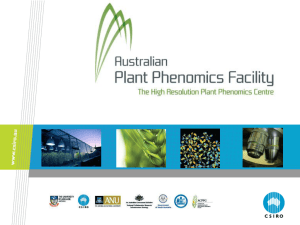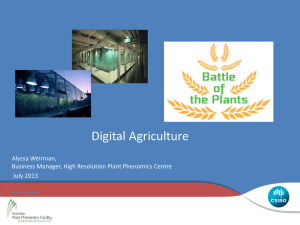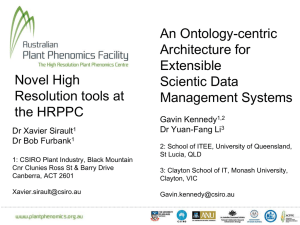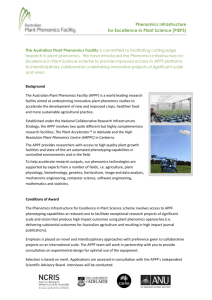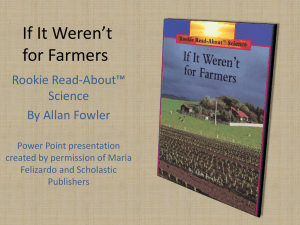to complement the Teacher`s Resource
advertisement
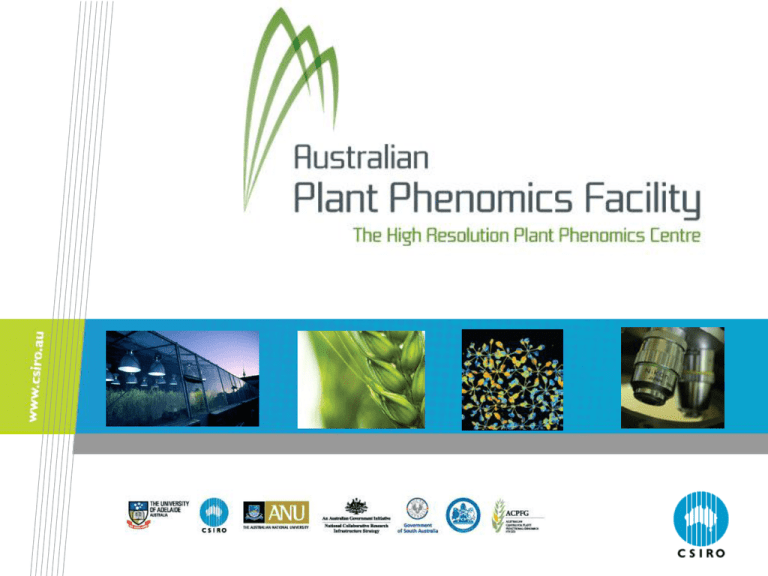
Plant phenomics Some background information A plant’s genotype is all of its genes. A plant’s phenotype is how it looks and performs: • a plant’s phenotype is a combination of its genotype and the environment it grows in • plants with the same genotype can have different phenotypes. Phenotyping is analysing a plant’s phenotype. Phenomics is a way of speeding up phenotyping using high-tech imaging systems and computing power. Why is plant phenomics important? By 2050, 9.1 billion people will populate the planet. We will need to produce 70 per cent more food to feed them, under tougher climate conditions. This is one of humanity’s greatest challenges. How can we do it? Three of the possible ways to help: • Improve crop yields • Breed crops that can cope with climate change • Develop biofuel crops that don’t compete with food crops. What does plant phenomics involve? Phenomics borrows imaging techniques from medicine to allow researchers to study the inner workings of leaves, roots or whole plants. Some phenomics techniques are: • • • • • 3D imaging infrared imaging fluorescence imaging magnetic resonance imaging spectral reflectance. Three-dimensional (3D) imaging Digital photos of the top and sides of plants are combined into a 3D image. Measurements that can be taken using a 3D image include: • shoot mass • leaf number, shape and angle • leaf colour • leaf health. 3D imaging A cotton plant prepared for imaging (above), and a 3D model (right) 3D imaging - PlantScan Pots of plants move on a conveyor belt through an imaging chamber. The 3D models are automatically generated by a computer program. 3D imaging - TrayScan The TrayScan system holds a mini-conveyor belt that cycles trays of plants through a hightech array of cameras. Each tray is labelled with a barcode so that plants can be easily identified. Far-infrared (FIR) imaging FIR cameras are used to study temperature. • They use light in the FIR region of the spectrum (15–1000 μm). Temperature differences can be used to study: • salinity tolerance • water usage • photosynthesis efficiency. Far-infrared (FIR) imaging Cooler plants have better root systems and take up more water. FIR imaging can be used for individual plants or for whole crops. Fluorescence imaging Fluorescence imaging is used to study plant health and photosynthesis. • Fluorescence occurs when an object absorbs light of one wavelength and gives off light of a different wavelength. Chlorophyll fluorescence is used to study the effect of different genes or environmental conditions on the efficiency of photosynthesis. Magnetic resonance imaging (MRI) Magnetic resonance imaging (MRI) is used to study plant roots. • MRI uses a magnetic field and radio waves to take images of roots in the same way as for imaging body organs in medicine. MRI allows the 3D geometry of roots to be viewed just as if the plant was growing in the soil. Spectral reflectance Spectral reflectance is the fraction of light reflected by a non-transparent surface. Researchers can use spectral reflectance to tell if a plant is stressed by saline soil or drought, well before it can be seen by eye. A hyperspectral camera measures all wavelengths of light that are either reflected or absorbed by a plant. Plant phenomics in the field Phenomics remote sensing technology allows researchers to study plants in the field. • Measurements can be taken on many plants at once, and over a whole growing season Some examples of phenomics field technology are: • • • • Phenonet sensor network Phenomobile Phenotower Multicopter. Phenonet sensor network A network of data loggers collects information from a field of crops and sends it through the mobile phone network to researchers at the lab. Sensors include: • • • • far infrared thermometer weather station soil moisture sensor thermistor (soil temperature) Phenomobile The phenomobile is a modified golf buggy that moves through a field of plants, taking measurements as is travels along. Phenomobile The phenomobile carries equipment to measure: • leaf greenness and ground cover • canopy temperature • volume (biomass) of plants, plant height and plant density • crop chemical composition. α Phenotower The phenotower is a cherry picker used to take images of crops 15 m above the ground. Multicopter The Multicopter can take infrared and colour images of a field from just a few centimetres above the ground to a height of up to 100 metres. Where is plant phenomics research done in Australia? The Australian Plant Phenomics Facility has two nodes: • Canberra: High Resolution Plant Phenomics Centre • Adelaide: The Plant Accelerator High Resolution Plant Phenomics Centre The Centre’s researchers develop new ways to discover the function of genes and to screen plant varieties for useful agricultural traits. Researchers can grow plants in growth cabinets or in the field. Plant Accelerator A high-tech glasshouse contains plant conveyor systems, and imaging, robotic and computing equipment. Research: Improving crop yields Yearly crop yield gains have slowed to the point of stagnation. Population growth + lack of suitable land + competition from biofuel crops + fertiliser costs + lack of water + climate change = potential global food crisis. Phenomics projects: • ‘Supercharging’ photosynthesis • Improving wheat yield • Brachypodium – the cereal ‘lab rat’ ‘Supercharging’ photosynthesis Plants have two major photosynthetic mechanisms: C3 and C4. Phenomics researchers want to replace the C3 pathway of rice with a more efficient C4 mechanism. C4 plants can concentrate carbon dioxide inside the leaf, and photosynthesise more efficiently than C3 plants, especially under: • higher temperatures • drought conditions • limited nitrogen supplies. Improving wheat yield A major limiting factor in photosynthetic performance is the inefficiency of the enzyme Rubisco. Some plants have better Rubiscos than others. Phenomics researchers are searching through thousands of wheat varieties for those: • with a better-performing Rubisco and higher rates of photosynthesis • that can grow well under nutrient deficiency, drought and salinity. Brachypodium – the cereal ‘lab rat’ Phenomics researchers are using a small wild grass called Brachypodium distachyon as a wheat ‘lab rat’. Brachypodium’s entire genome is known, and it has many genes in common with wheat. Researchers are studying Brachypodium root formation to speed up understanding of wheat roots. Research: Crops to cope with climate change Climate change is predicted to make crop growing conditions tougher in the future. Phenomics researchers are developing: • drought-tolerant wheat • salt-tolerant wheat and barley. Drought-tolerant wheat Crops use different amounts of water at different growth stages and under different environmental conditions. To breed drought-tolerant wheat, researchers have to study performance in the field over a whole growing season. Phenomics remote sensing technology can measure: • if plants are stressed by drought conditions • canopy temperature • weather and soil data. Salt-tolerant wheat and barley CSIRO researchers are screening wheat and barley growing in saline conditions for salt-tolerant varieties. Plants grown in salty soil close their stomata to reduce water loss. This: • slows photosynthesis and reduces yield • heats the leaves. Infrared cameras can quickly identify which plants are cooler, and are keeping their stomata open. Plant grown in salty soil (warmer) Plant grown in normal soil (cooler) Research: Non-food crop biofuels Biofuels are often produced using food crops such as corn and soybeans. Researchers are trialling nonfood plants to produce biofuels. These crops will need to: • grow on less productive land ‘marginal’ land • tolerate stresses, such as low water availability, salinity or low nutrient supplies. Switchgrass (Panicum virgatum) is showing promise as a biofuel feedstock.
